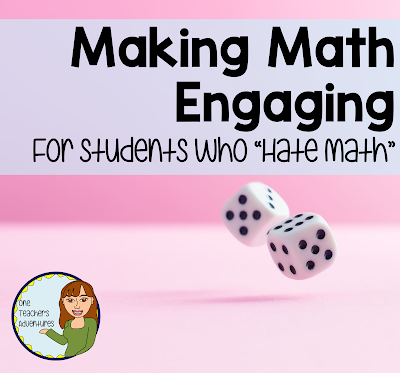We've all heard it: "I hate math!" Whether it's frustration, past struggles, or just disinterest, some students come into our classrooms with their minds made up. But as teachers, we know that math isn't the enemy — and we can change the way our students see it. By making math hands-on, relevant, and interactive, we can help them develop confidence and maybe even enjoy it. Here are some strategies to make math more engaging in middle school:
1. Get Hands-On
Math can feel abstract, but giving students something to touch can make a huge difference.
Use manipulatives like fraction tiles, algebra tiles, and pattern blocks.
Bring in real-world connections like planning a trip on a budget, doubling or halving a recipe (then having students make the dish!), or designing a dream bedroom with area and perimeter. I've had students plan field trips that they'd like to take - looking at bus schedules, budgets, and timetables. Not only did it engage them in their learning, but they were able to realize the amount of work that goes into field trips!
Make it a game! Board games, escape rooms, and card games make practicing math skills way more fun. Check out this blog post for a collection of math games.
2. Connect Math to What They Love
When math relates to students' interests, it stops feeling like a chore.
Sports fans? Analyze player stats or calculate probabilities in their favorite games.
Artists? Explore symmetry, tessellations, and geometric designs in art.
Gamers? Dive into probability, coordinate planes, or algorithms using video games.
Social media lovers? Look at engagement rates, data trends, and digital marketing analytics.
Projects like Show Me Your Math are a great starting point for teachers to plan!
3. Make It Social
Middle schoolers love to talk, so let’s use that to our advantage.
Think-Pair-Share: Let students talk through problems before solving them.
Math Stations: Set up different activities that students rotate through in small groups.
Group Challenges: Have teams tackle real-world problems together. My students love to try Ted-ED riddles!
4. Build a Growth Mindset
Many students think they’re just "bad at math." We can help shift that mindset by:
Praising effort and perseverance rather than just correct answers.
Sharing stories of famous mathematicians who struggled but kept going.
Encouraging students to see mistakes as part of the learning process.
5. Turn Math into a Story
A good story pulls students in, so why not apply that to math?
Mystery Math: Solve equations to unlock clues in a mystery.
Math Adventures: Create a class-wide challenge where students solve math problems to progress.
Historical Math: Explore how ancient civilizations used math to build pyramids, trade goods, or navigate seas.
6. Celebrate the Wins
Changing attitudes about math doesn’t happen overnight, but celebrating small victories helps.
Display student work and progress.
Give fun incentives for effort and participation.
Recognize growth, not just perfect scores.
At the end of the day, our goal isn’t just to teach math—it’s to help students see that they can do math. The more we make it hands-on, relevant, and fun, the more likely they are to believe in themselves. What’s worked for you? Drop your ideas in the comments!


Comments
Post a Comment